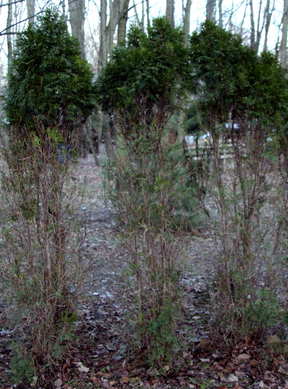Pruning conifers
Editor’s note: This article is from the archives of the MSU Crop Advisory Team Alerts. Check the label of any pesticide referenced to ensure your use is included
As I noted in the last Landscape Alert, we are seeing a lot of various forms of winter injury on conifers as we move into spring. This has prompted a lot of calls to county MSU Extension offices from homeowners asking when and how to prune their damaged evergreens.
Here are a few factors to consider before pruning conifers.
What caused the damage?
The most common problems we’re seeing right now are the browning of needles and deer browse damage. Needle browning can be caused by a couple of factors, but the most common this winter are winter desiccation on spruces and salt damage on sensitive plants such as white pine. Deer will browse many evergreens, but arborvitae seem to be their all-time favorite.
Wait and see or prune now?
Needle browning problems are often not as bad as they first appear in the early spring. The key factor is whether or not buds were killed. Conifers such as pines and spruce can often withstand significant needle browning, either from winter desiccation or salt exposure, and still put on a new flush of growth in the spring since their buds are protected by bud scales. For plants like junipers, it’s often best to prune out the affected area and allow the unaffected parts of the plant to fill in (see photo 1). Remember junipers will not put on new growth from old wood, so big holes will have to fill in from the undamaged foliage. Also, it’s important to develop a strategy to keep damage from re-occurring. Most conifers can handle a single season of fairly severe salt damage and recover, but after two or more years of damage the plant will run out of energy reserves to put on new growth.

Juniper damaged by winter injury.
Photo credit: J. Stanger
Likewise, for arborvitae damaged by deer (see photo 2) the key question is, can deer be excluded? If not, then the damage is almost certain to re-occur and eventually the lower branches will no longer push new growth. If deer can be managed, fencing, dogs, high velocity lead, etc., the trees will push new growth and eventually recover. Light pruning of the tops can help to keep the plant in balance.

Arborvitae damaged by deer.
Photo credit: J. Stanger
For pruning large branches on conifers damage by snow or ice, the same principles and procedures for pruning large, deciduous trees apply. See the US Forest Service guide one how to prune trees:
http://www.na.fs.fed.us/Spfo/pubs/howtos/ht_prune/prun001.htm
For additional tips on pruning conifers go to:
http://www.finegardening.com/how-to/videos/pruning-conifers-for-health.aspx?nterms=74858



 Print
Print Email
Email

